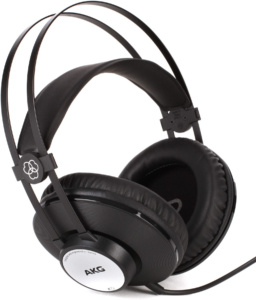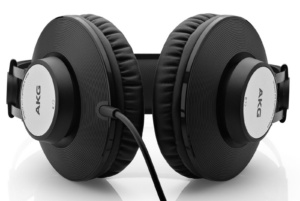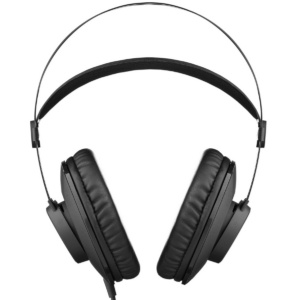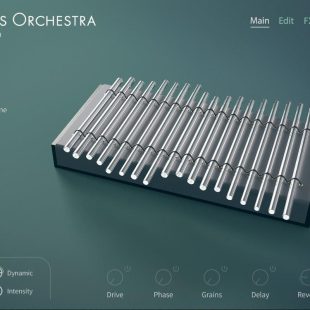AKG K72 Headphones
 Hi, and welcome to our hands-on review of AKG‘s brand-new K72 closed-back headphones. Smack in the middle of the range, the K72 features the same basic design as its brethren, the K52, and K92, with silver end-caps and a very slight low-end range of 16Hz – 20KHz over the base 18-20Khz of the K52. All come with a 3m cable, screw-on 6.3mm jack connector and comfortable self-adjusting headband.
Hi, and welcome to our hands-on review of AKG‘s brand-new K72 closed-back headphones. Smack in the middle of the range, the K72 features the same basic design as its brethren, the K52, and K92, with silver end-caps and a very slight low-end range of 16Hz – 20KHz over the base 18-20Khz of the K52. All come with a 3m cable, screw-on 6.3mm jack connector and comfortable self-adjusting headband.
On first unboxing, the K72 looks very sleek and attractive in an almost retro style. My initial concerns about the super-lightweight of the K72s have been alleviated now having found the overall build quality to be excellent.
The self-adjusting headband is well designed and works perfectly to cradle your head though I found the earpads fit almost too well and cause painful pressure and sucking on your eardrums if you squish them in too tight. The replaceable foam muffs have a vinyl leather-like covering that is comfortable, even over extended listening periods, though they can get a little sweaty sometimes.
Roadtest
Being a review model I didn’t want to risk breaking them by doing various drop tests (or the obligatory ‘engineer sit on’ test), though they feel resilient to twisting and pulling, though a little plasticky sounding when tapped (especially when wearing). The steel headband has an elastic inner padded inner piece that stretches to your head shape. This design is way more comfortable than the other units we have with extendable sides; I never experienced any sore spots on the top of my head that I often get with heavier cans. Unfortunately, the muffs don’t fold, so single-ear listening is a no-go unless you position one on the back of your head, which kind of works too.
Having used the K72 now for over a week in the studio, I have mixed (no pun intended) results with the areas I used them. Unfortunately for the little AKGs, the only other pair of working headphones we have in the studio to compare them with is the stellar Shure SRH840s with 920 drivers fitted, so the deck is stacked against it from the get-go. When in straight A/B comparison, the AKG has no hope to match the incredible Shure units in sound quality, but the K72 have strengths Shure could take on board. Though as mentioned they are very light, there are no visible weak spots or stress points in the design, unlike the Shure units which due to their weight have cracked and the headband foam has started to come away over the years.
In the Studio
The K72 features good size 40mm low impedance drivers (meaning you can plug these directly into your iPod, and they’ll work just fine). They have a closed-back design and a newly designed cavity designed to keep sound from leaking while preserving listening quality. In our testing, this proved to be pretty good, only when blasting at painful levels did any audio escape when placed correctly over your head. The high-end crack of a snare drum and other similar dynamic instruments were noticeable when soloing such instruments on a multi-track mix. We will trust the advertised frequency range of 18hz – 20khz is reasonably accurate as we found a full range of tones well-defined when swept using a complex synth sine wave patch, but the headphones have a distinct mid-range hump when full mixed tracks played.
When listening to pre-recorded Mp3 music, we found the K72s to be very mid-heavy, particularly around the 1k range in most music. There is also a distinct 6-7k nasty sizzle present in the music that features plenty of high-end fidelity, though not evident in all music tracks we tested with. The mid-range is a characteristic of these types of close-back designs that you will need a much bigger budget to smoothen out, and to be honest not as much of an issue for me after some time allowing your ears to normalize to the sound. When compared to our SRH the K72 has a distinctly small sound stage, coming mainly from that hyper mid-range.
There is some weirdness going on in the bass register that I can’t quite put my finger on, but most music tracks we played displayed good sub-bass presence with a noticeable lack of punch in the 100-160k range, which often gave the music a thin quality.
Is this such a bad thing? Well, not really, depending on how you’re using them. We recorded a small jam session here in the Music Nation studio using a vocalist wearing the K72s while playing acoustic guitar, a second guitarist, bass and programmed drums. For tracking, the mid-range hump is handy to help bring forward the voice, and the dip in the bass range helped clean up the low frequencies from the kick and bass guitar being fed back through to her as a monitor. Vocal reverb didn’t sound as wide as it did through the Shure headphones, but the important parts like her voice and guitar were well-defined and clear. So as a tracking monitor, we found the K72s to be excellent for detailing important parts of the mix, not so much at flattering the over mix. The natural ability of the design to block audio spill was great, especially when dealing with multiple users in a small recording environment like this.
Conclusion
The AKG K72 is a trooper with an unexpectedly solid lightweight build. I hate to use the phrase ‘Good value for the money’, but you do get excellent value here as long as you’re expecting audiophile sonic delivery. The light plastic chassis just can’t deliver quality anywhere near good enough for reference critical tasks like mixing and mastering, but due to its enhanced midrange hump, it is a strong contender for tracking. Sometimes what you need is a good enough sounding, dependable and musician-proof headphone when tracking or even rehearsing bands, this is where the K72 will shine. We don’t have time to put these to a 5-year test in the studio, but I feel these will last the long haul if treated with respect, the only area I think might give you trouble is the cable, as it’s not reinforced or braided – a good yank and I think it might come out of the headphone cup.
But all in all, a good experience with the K72, a well-designed and priced contender for any studio tracking situation.
$129.95 RRP
Available at any decent music shop or directly from AKG right here:
http://www.jandsonline.co.nz/products/akg-k72-pro-closed-back-headphones






